Peide Cai
Carl-Lead: Lidar-based End-to-End Autonomous Driving with Contrastive Deep Reinforcement Learning
Sep 17, 2021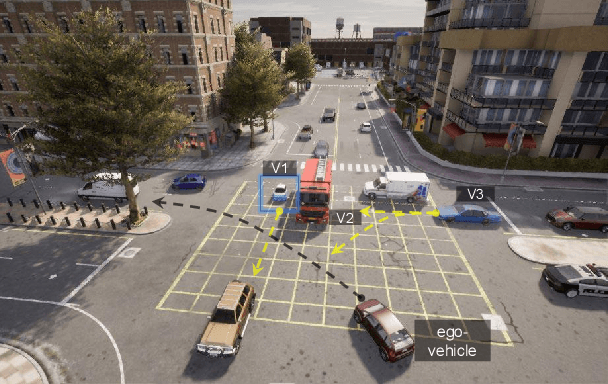

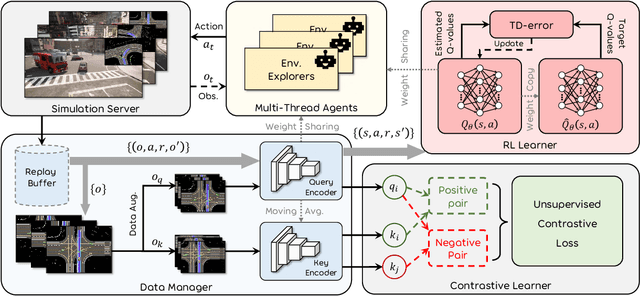
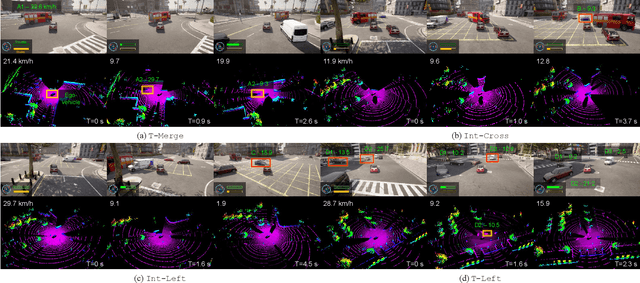
Abstract:Autonomous driving in urban crowds at unregulated intersections is challenging, where dynamic occlusions and uncertain behaviors of other vehicles should be carefully considered. Traditional methods are heuristic and based on hand-engineered rules and parameters, but scale poorly in new situations. Therefore, they require high labor cost to design and maintain rules in all foreseeable scenarios. Recently, deep reinforcement learning (DRL) has shown promising results in urban driving scenarios. However, DRL is known to be sample inefficient, and most previous works assume perfect observations such as ground-truth locations and motions of vehicles without considering noises and occlusions, which might be a too strong assumption for policy deployment. In this work, we use DRL to train lidar-based end-to-end driving policies that naturally consider imperfect partial observations. We further use unsupervised contrastive representation learning as an auxiliary task to improve the sample efficiency. The comparative evaluation results reveal that our method achieves higher success rates than the state-of-the-art (SOTA) lidar-based end-to-end driving network, better trades off safety and efficiency than the carefully tuned rule-based method, and generalizes better to new scenarios than the baselines. Demo videos are available at https://caipeide.github.io/carl-lead/.
R-PCC: A Baseline for Range Image-based Point Cloud Compression
Sep 16, 2021


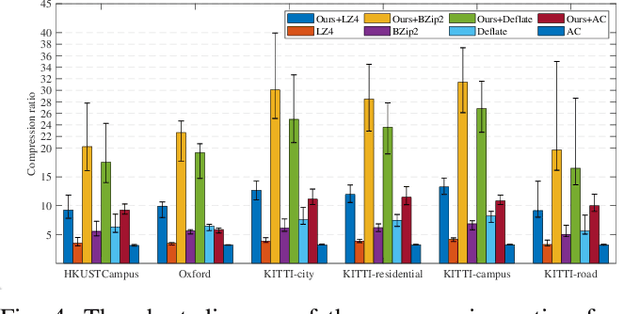
Abstract:In autonomous vehicles or robots, point clouds from LiDAR can provide accurate depth information of objects compared with 2D images, but they also suffer a large volume of data, which is inconvenient for data storage or transmission. In this paper, we propose a Range image-based Point Cloud Compression method, R-PCC, which can reconstruct the point cloud with uniform or non-uniform accuracy loss. We segment the original large-scale point cloud into small and compact regions for spatial redundancy and salient region classification. Compared with other voxel-based or image-based compression methods, our method can keep and align all points from the original point cloud in the reconstructed point cloud. It can also control the maximum reconstruction error for each point through a quantization module. In the experiments, we prove that our easier FPS-based segmentation method can achieve better performance than instance-based segmentation methods such as DBSCAN. To verify the advantages of our proposed method, we evaluate the reconstruction quality and fidelity for 3D object detection and SLAM, as the downstream tasks. The experimental results show that our elegant framework can achieve 30$\times$ compression ratio without affecting downstream tasks, and our non-uniform compression framework shows a great improvement on the downstream tasks compared with the state-of-the-art large-scale point cloud compression methods. Our real-time method is efficient and effective enough to act as a baseline for range image-based point cloud compression. The code is available on https://github.com/StevenWang30/R-PCC.git.
DQ-GAT: Towards Safe and Efficient Autonomous Driving with Deep Q-Learning and Graph Attention Networks
Aug 11, 2021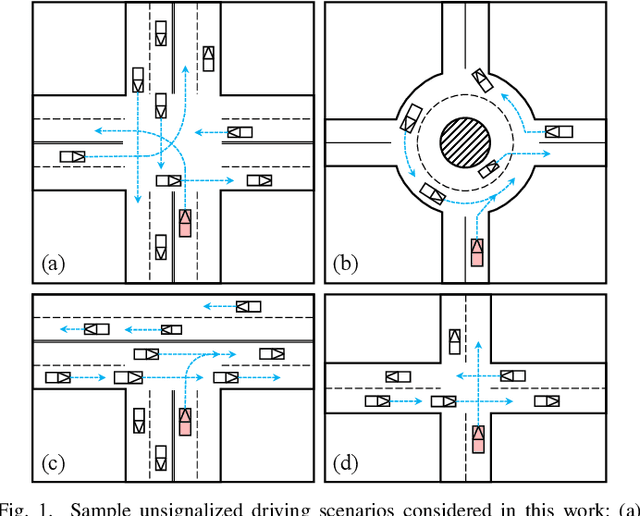


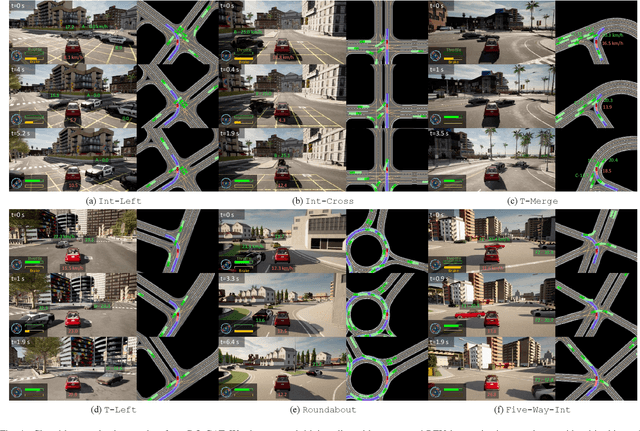
Abstract:Autonomous driving in multi-agent and dynamic traffic scenarios is challenging, where the behaviors of other road agents are uncertain and hard to model explicitly, and the ego-vehicle should apply complicated negotiation skills with them to achieve both safe and efficient driving in various settings, such as giving way, merging and taking turns. Traditional planning methods are largely rule-based and scale poorly in these complex dynamic scenarios, often leading to reactive or even overly conservative behaviors. Therefore, they require tedious human efforts to maintain workability. Recently, deep learning-based methods have shown promising results with better generalization capability but less hand engineering effort. However, they are either implemented with supervised imitation learning (IL) that suffers from the dataset bias and distribution mismatch problems, or trained with deep reinforcement learning (DRL) but focus on one specific traffic scenario. In this work, we propose DQ-GAT to achieve scalable and proactive autonomous driving, where graph attention-based networks are used to implicitly model interactions, and asynchronous deep Q-learning is employed to train the network end-to-end in an unsupervised manner. Extensive experiments through a high-fidelity driving simulation show that our method can better trade-off safety and efficiency in both seen and unseen scenarios, achieving higher goal success rates than the baselines (at most 4.7$\times$) with comparable task completion time. Demonstration videos are available at https://caipeide.github.io/dq-gat/.
SNE-RoadSeg+: Rethinking Depth-Normal Translation and Deep Supervision for Freespace Detection
Jul 30, 2021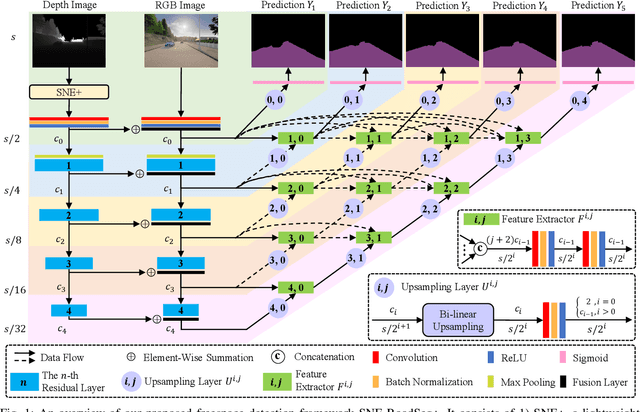

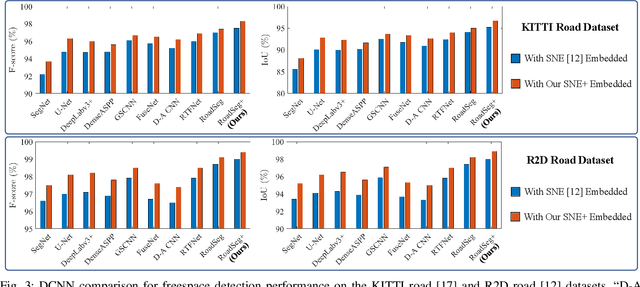
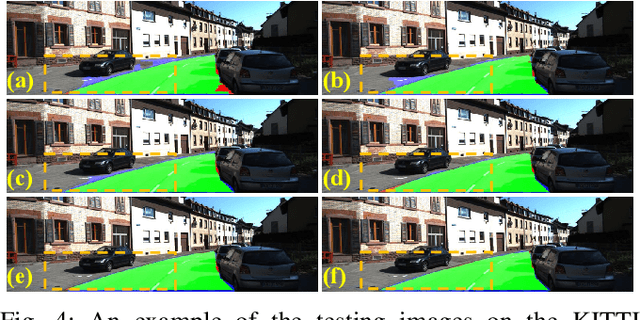
Abstract:Freespace detection is a fundamental component of autonomous driving perception. Recently, deep convolutional neural networks (DCNNs) have achieved impressive performance for this task. In particular, SNE-RoadSeg, our previously proposed method based on a surface normal estimator (SNE) and a data-fusion DCNN (RoadSeg), has achieved impressive performance in freespace detection. However, SNE-RoadSeg is computationally intensive, and it is difficult to execute in real time. To address this problem, we introduce SNE-RoadSeg+, an upgraded version of SNE-RoadSeg. SNE-RoadSeg+ consists of 1) SNE+, a module for more accurate surface normal estimation, and 2) RoadSeg+, a data-fusion DCNN that can greatly minimize the trade-off between accuracy and efficiency with the use of deep supervision. Extensive experimental results have demonstrated the effectiveness of our SNE+ for surface normal estimation and the superior performance of our SNE-RoadSeg+ over all other freespace detection approaches. Specifically, our SNE-RoadSeg+ runs in real time, and meanwhile, achieves the state-of-the-art performance on the KITTI road benchmark. Our project page is at https://www.sne-roadseg.site/sne-roadseg-plus.
Vision-Based Autonomous Car Racing Using Deep Imitative Reinforcement Learning
Jul 18, 2021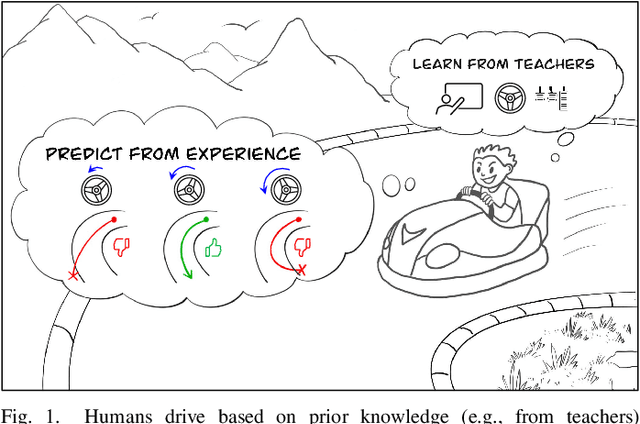



Abstract:Autonomous car racing is a challenging task in the robotic control area. Traditional modular methods require accurate mapping, localization and planning, which makes them computationally inefficient and sensitive to environmental changes. Recently, deep-learning-based end-to-end systems have shown promising results for autonomous driving/racing. However, they are commonly implemented by supervised imitation learning (IL), which suffers from the distribution mismatch problem, or by reinforcement learning (RL), which requires a huge amount of risky interaction data. In this work, we present a general deep imitative reinforcement learning approach (DIRL), which successfully achieves agile autonomous racing using visual inputs. The driving knowledge is acquired from both IL and model-based RL, where the agent can learn from human teachers as well as perform self-improvement by safely interacting with an offline world model. We validate our algorithm both in a high-fidelity driving simulation and on a real-world 1/20-scale RC-car with limited onboard computation. The evaluation results demonstrate that our method outperforms previous IL and RL methods in terms of sample efficiency and task performance. Demonstration videos are available at https://caipeide.github.io/autorace-dirl/
End-to-End Interactive Prediction and Planning with Optical Flow Distillation for Autonomous Driving
Apr 18, 2021
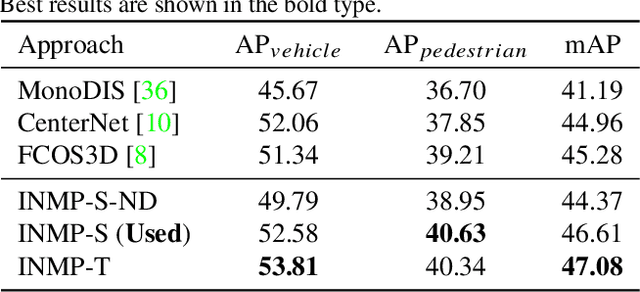
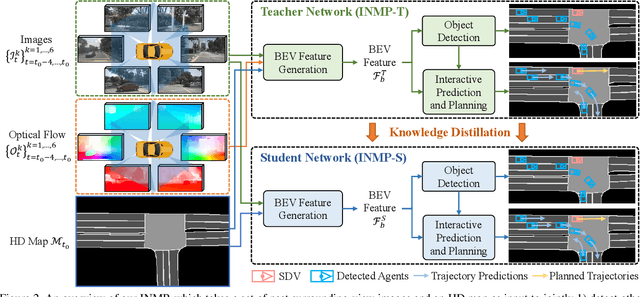
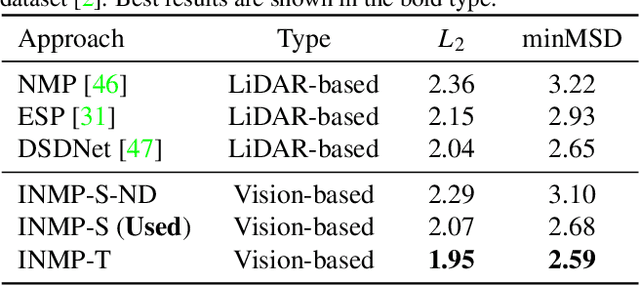
Abstract:With the recent advancement of deep learning technology, data-driven approaches for autonomous car prediction and planning have achieved extraordinary performance. Nevertheless, most of these approaches follow a non-interactive prediction and planning paradigm, hypothesizing that a vehicle's behaviors do not affect others. The approaches based on such a non-interactive philosophy typically perform acceptably in sparse traffic scenarios but can easily fail in dense traffic scenarios. Therefore, we propose an end-to-end interactive neural motion planner (INMP) for autonomous driving in this paper. Given a set of past surrounding-view images and a high definition map, our INMP first generates a feature map in bird's-eye-view space, which is then processed to detect other agents and perform interactive prediction and planning jointly. Also, we adopt an optical flow distillation paradigm, which can effectively improve the network performance while still maintaining its real-time inference speed. Extensive experiments on the nuScenes dataset and in the closed-loop Carla simulation environment demonstrate the effectiveness and efficiency of our INMP for the detection, prediction, and planning tasks. Our project page is at sites.google.com/view/inmp-ofd.
Learning Interpretable End-to-End Vision-Based Motion Planning for Autonomous Driving with Optical Flow Distillation
Apr 18, 2021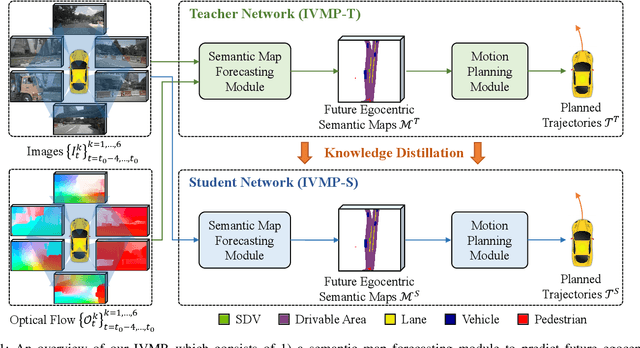
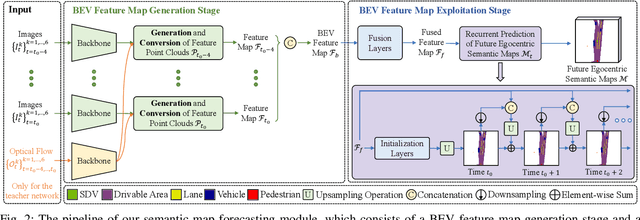

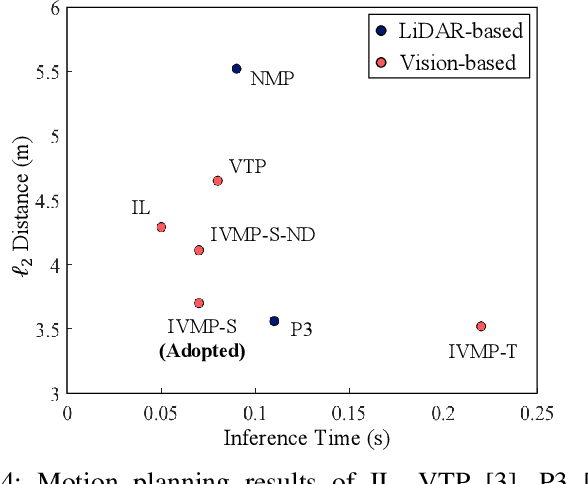
Abstract:Recently, deep-learning based approaches have achieved impressive performance for autonomous driving. However, end-to-end vision-based methods typically have limited interpretability, making the behaviors of the deep networks difficult to explain. Hence, their potential applications could be limited in practice. To address this problem, we propose an interpretable end-to-end vision-based motion planning approach for autonomous driving, referred to as IVMP. Given a set of past surrounding-view images, our IVMP first predicts future egocentric semantic maps in bird's-eye-view space, which are then employed to plan trajectories for self-driving vehicles. The predicted future semantic maps not only provide useful interpretable information, but also allow our motion planning module to handle objects with low probability, thus improving the safety of autonomous driving. Moreover, we also develop an optical flow distillation paradigm, which can effectively enhance the network while still maintaining its real-time performance. Extensive experiments on the nuScenes dataset and closed-loop simulation show that our IVMP significantly outperforms the state-of-the-art approaches in imitating human drivers with a much higher success rate. Our project page is available at https://sites.google.com/view/ivmp.
PVStereo: Pyramid Voting Module for End-to-End Self-Supervised Stereo Matching
Mar 12, 2021



Abstract:Supervised learning with deep convolutional neural networks (DCNNs) has seen huge adoption in stereo matching. However, the acquisition of large-scale datasets with well-labeled ground truth is cumbersome and labor-intensive, making supervised learning-based approaches often hard to implement in practice. To overcome this drawback, we propose a robust and effective self-supervised stereo matching approach, consisting of a pyramid voting module (PVM) and a novel DCNN architecture, referred to as OptStereo. Specifically, our OptStereo first builds multi-scale cost volumes, and then adopts a recurrent unit to iteratively update disparity estimations at high resolution; while our PVM can generate reliable semi-dense disparity images, which can be employed to supervise OptStereo training. Furthermore, we publish the HKUST-Drive dataset, a large-scale synthetic stereo dataset, collected under different illumination and weather conditions for research purposes. Extensive experimental results demonstrate the effectiveness and efficiency of our self-supervised stereo matching approach on the KITTI Stereo benchmarks and our HKUST-Drive dataset. PVStereo, our best-performing implementation, greatly outperforms all other state-of-the-art self-supervised stereo matching approaches. Our project page is available at sites.google.com/view/pvstereo.
Learning Collision-Free Space Detection from Stereo Images: Homography Matrix Brings Better Data Augmentation
Dec 14, 2020
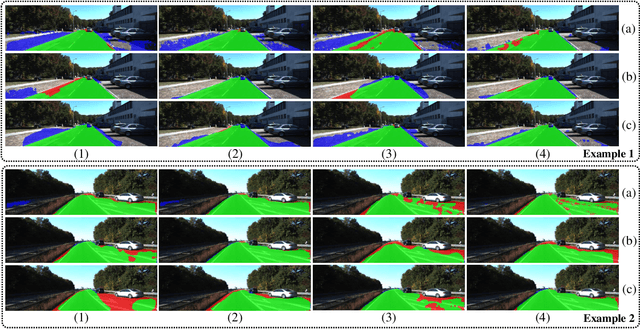
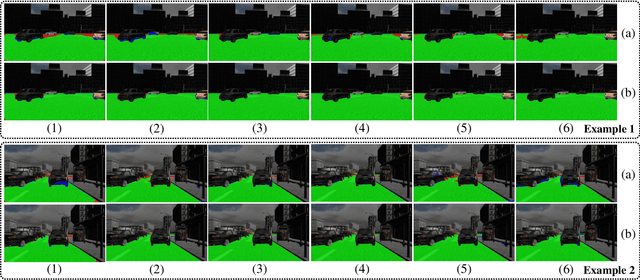
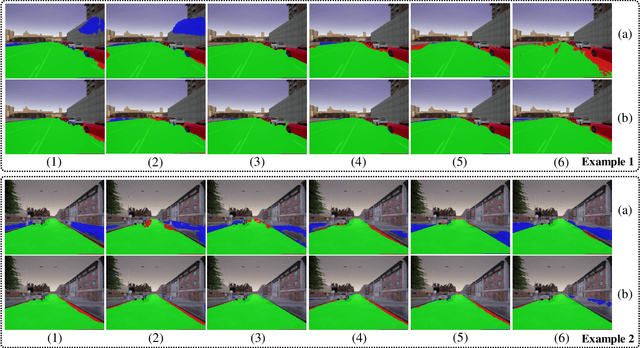
Abstract:Collision-free space detection is a critical component of autonomous vehicle perception. The state-of-the-art algorithms are typically based on supervised learning. The performance of such approaches is always dependent on the quality and amount of labeled training data. Additionally, it remains an open challenge to train deep convolutional neural networks (DCNNs) using only a small quantity of training samples. Therefore, this paper mainly explores an effective training data augmentation approach that can be employed to improve the overall DCNN performance, when additional images captured from different views are available. Due to the fact that the pixels of the collision-free space (generally regarded as a planar surface) between two images captured from different views can be associated by a homography matrix, the scenario of the target image can be transformed into the reference view. This provides a simple but effective way of generating training data from additional multi-view images. Extensive experimental results, conducted with six state-of-the-art semantic segmentation DCNNs on three datasets, demonstrate the effectiveness of our proposed training data augmentation algorithm for enhancing collision-free space detection performance. When validated on the KITTI road benchmark, our approach provides the best results for stereo vision-based collision-free space detection.
Learning Scalable Self-Driving Policies for Generic Traffic Scenarios
Nov 13, 2020



Abstract:Robust and safe self-driving in complex and dynamic environments is quite challenging due to the requirement of scalable driving policies against the wide variety of traffic scenarios (e,g., road topologies, traffic rules and interaction with road agents). In this area, traditional modular frameworks scale poorly in new environments, and require tremendous and iterative hand-tuning of rules and parameters to maintain performance in all foreseeable scenarios. Recently, deep-learning based self-driving methods have shown promising results with better generalization capability but less hand engineering effort. However, most of the previous methods are trained and evaluated in limited and simple environments with scattered tasks, such as lane-following, autonomous braking and conditional driving. In this paper, we propose a graph-based deep network to achieve unified and scalable self-driving in diverse dynamic environments. The extensive evaluation results show that our model can safely navigate the vehicle in a large variety of urban, rural, and highway areas with dense traffic while obeying traffic rules. Specifically, more than 7,500 km of closed-loop driving evaluation is conducted in dynamic simulation environments, in which our method can handle complex driving situations, and achieve higher success rates (73.5%-83.2%) and driving scores than the baselines.
 Add to Chrome
Add to Chrome Add to Firefox
Add to Firefox Add to Edge
Add to Edge